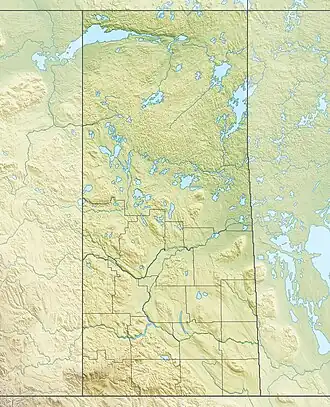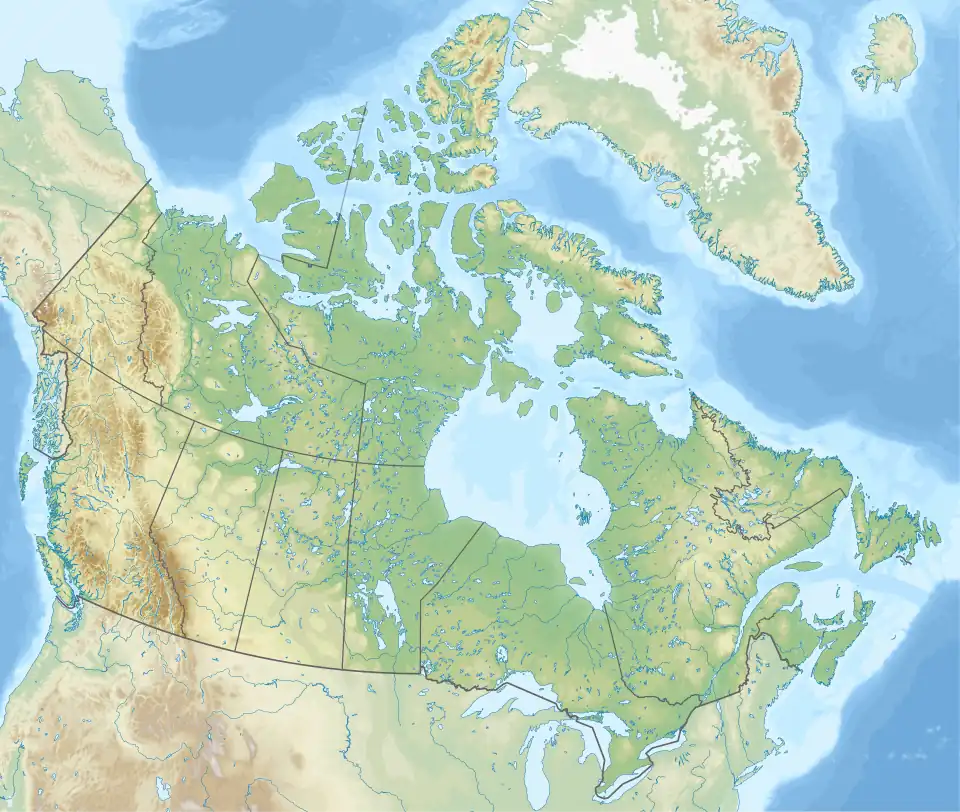Hoidas Lake
| Hoidas Lake | |
|---|---|
 Hoidas Lake Location in Saskatchewan  Hoidas Lake Hoidas Lake (Canada) | |
| Location | Northern Saskatchewan Administration District |
| Coordinates | 59°55′41″N 107°49′12″W / 59.928°N 107.820°W |
| Basin countries | Canada |
| Max. length | 3.7 km (2.3 mi) |
| Surface area | 180.5 ha (446 acres) |
| Shore length1 | 11 km (6.8 mi) |
| Surface elevation | 451 m (1,480 ft) |
| 1 Shore length is not a well-defined measure. | |
Hoidas Lake is a small, remote northern lake in the Canadian province of Saskatchewan.[1][2] It is about 7 kilometres (4.3 mi) south of the Saskatchewan–Northwest Territories border and 50 kilometres (31 mi) north of Uranium City in the Tazin River watershed.[3] Named in honour of Irvin Frank Hoidas, a Royal Canadian Air Force pilot officer killed in action during the Second World War when his Stirling W-7520 crashed near the Belgian town of Sint-Truiden,[4][5] it is the site of Canada's most advanced rare-earth element (REE) mining project.[6]
Setting
Hoidas Lake lies in the Northern Rae Geological Province, in the general vicinity of many of Saskatchewan's large uranium mines.
Mineralogy
The mineralogy of the Hoidas Lake rare-earth deposit differs from most other such deposits in that it is hosted in veins of apatite and allanite.[7] Hoidas Lake also differs from other deposits in that it contains a significant amount of heavy rare-earth elements, such as dysprosium. This abundance of heavy REEs is significant, as there is a growing demand for the heavier rare earths in high-tech manufacturing (such as the use of dysprosium in the manufacturing of hybrid car components).[8][9] Mineralization is presumably hydrothermal, from an alkali or carbonatitic source at depth.[10]
The main prospective zone is composed of two dominant rock types: a variably deformed monzogranite and a granodioritic to tonalitic gneiss. Both are Paleoproterozoic to Archean in age.[11]
Resource scale
Ongoing work at Hoidas Lake has delineated a vein system (known as the JAK zone), which extends for at least a kilometre along the strike.[10] The limits of the system have not been established along the strike nor along the dip,[10] and the zone's total extension is therefore unknown. The resource zone averages 75 m in width[12] and is composed of individual veins which, though ranging from one to eleven metres in thickness, average about three metres each.[10] Veins are continuous to 300 m depth and follow an anastomosing (branching) geometry.[10]
Estimates of the resource, given current delineations and assuming a 1.5% total rare-earth cutoff, have established a presence of at least 286,000 tonnes of rare-earth ore, which is enough to supply more than 10% of the North American market for the foreseeable future.
Ownership
The Hoidas Lake claims are owned by Great Western Minerals Group, based in Saskatoon.
See also
References
- ^ "Hoidas Lake". Canadian Geographical Names Database. Government of Canada. Retrieved 8 July 2025.
- ^ Siemens, Matthew. "Hoidas Lake". Sask Lakes. Retrieved 16 July 2025.
- ^ "Tazin River". Canadian Geographical Names Database. Government of Canada. Retrieved 16 July 2025.
- ^ "Irvin Frank Hoidas". Archived from the original on 27 November 2009. Retrieved 30 March 2008.
- ^ "Heverlee".
- ^ "Hoidas Lake, Saskatchewan, Canada". mindat.org. Retrieved 17 July 2025.
- ^ Salvi S, Williams‐Jones A. 2004. Alkaline granite‐syenite deposits. In Linnen RL, Samson IM, editors. Rare element geochemistry and mineral deposits. St. Catharines (ON): Geological Association of Canada. pp. 315–341
- ^ "INTERVIEW-Japan urges China to ease rare metals supply". Reuters. 8 November 2007. Retrieved 9 May 2023.
- ^ "The Anchor House, Inc. – Research on Rare Earth Elements". Retrieved 9 May 2023.
- ^ a b c d e Halpin, Kimberley Michelle (January 2010). "The characteristics and origin of the Hoidas Lake REE Deposit". Retrieved 2 June 2020.
- ^ Geology of the LeBlanc-Wellington lakes area, eastern Zemlak Domain, Rae Province; in Summary of Investigations 2003, v. 2, Saskatchewan Geological Survey, Sask. Industry and Resources, Misc. Rep. 2003-4.2. Available through: http://www.er.gov.sk.ca/adx/aspx/adxGetMedia.aspx?DocID=11840,11458,11455,11228,3385,5460,2936,Documents&MediaID=36607&Filename=Ashton03_SOIMAP_West.pdf
- ^ Pearson, J., (2006): Great Western Minerals Group Ltd. Assessment Report on the 2005-2006 Work Program, Hoidas Lake Rare Earth Project. Submitted to Saskatchewan Industry and Resources. Cited (at page six) in: http://library2.usask.ca/theses/available/etd-01292010-141709/unrestricted/Halpin_K.pdf